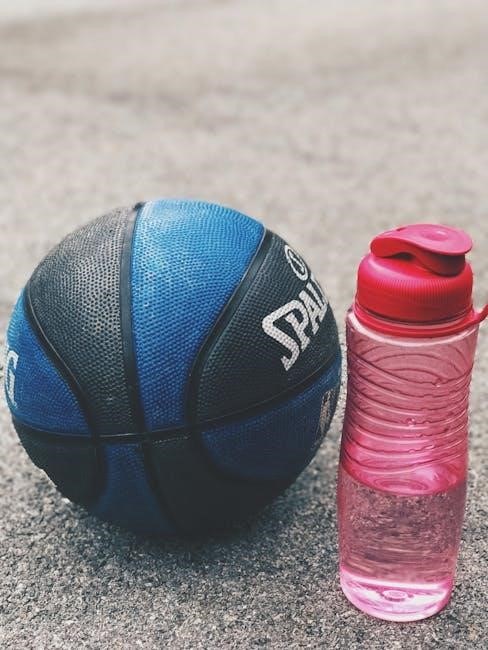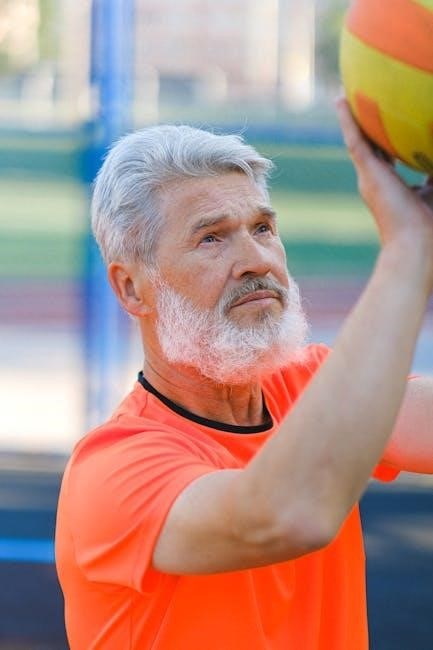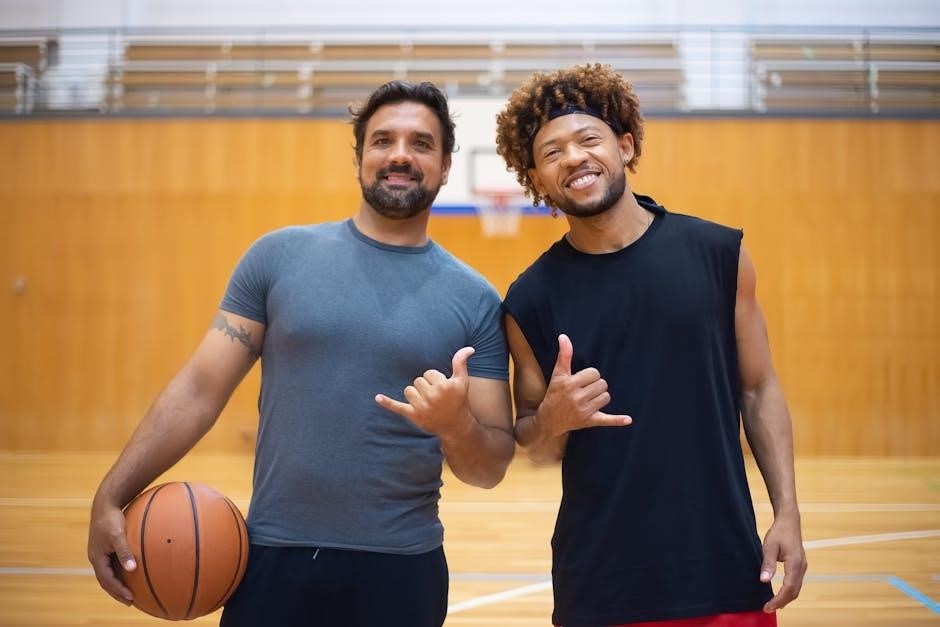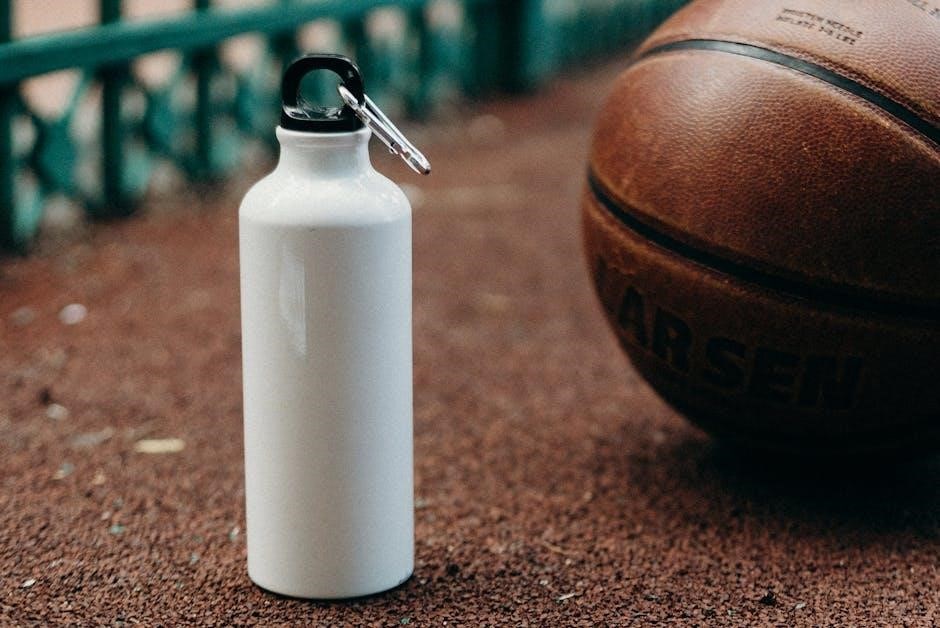A well-structured basketball workout plan is essential for improving skills, endurance, and overall performance․ It provides a comprehensive guide to organizing training sessions effectively, ensuring consistent progress and peak conditioning․
1․1 What is a Basketball Workout Plan?
A basketball workout plan is a structured program designed to enhance player performance through targeted exercises and drills․ It typically includes skill development, strength training, conditioning, and flexibility routines․ The plan is tailored to address specific goals, such as improving shooting, dribbling, or endurance․ Coaches and players use these plans to organize practices, track progress, and ensure consistent improvement․ A well-designed basketball workout plan balances physical conditioning with skill refinement, helping athletes achieve peak performance during games and tournaments․ It serves as a roadmap for systematic development․
1․2 Importance of a Structured Workout Plan
A structured basketball workout plan ensures efficient use of time and resources, maximizing player development․ It helps build discipline, consistency, and accountability, which are crucial for success․ By focusing on specific skills and fitness goals, players can address weaknesses and enhance strengths․ A structured plan also reduces the risk of overtraining or neglecting key areas, ensuring a balanced approach to improvement․ This organized method fosters measurable progress, keeping players motivated and focused on achieving their objectives effectively․

1․3 Benefits of Using a PDF Format
Using a basketball workout plan in PDF format offers numerous advantages․ PDFs are easily accessible on any device, ensuring players and coaches can review the plan anytime, anywhere․ They maintain consistent formatting, making the content clear and professional․ PDFs are also simple to share and print, allowing for seamless distribution among team members․ Additionally, PDFs are eco-friendly, reducing the need for paper․ Their structure enables detailed yet organized content, making workout plans comprehensive and easy to follow․ This format is ideal for creating and implementing effective training programs․

Components of a Basketball Workout Plan
A basketball workout plan typically includes warm-ups, skill drills, strength training, conditioning exercises, and flexibility routines․ These components ensure a well-rounded approach to improving performance and durability․
2․1 Warm-Up and Cool-Down Routines
Warm-up and cool-down routines are crucial for preparing the body and mind for basketball training․ A dynamic warm-up includes light cardio, stretching, and mobility exercises to increase blood flow and flexibility․ This helps prevent injuries and enhances performance․ Cool-downs involve static stretches and foam rolling to relax muscles, improve recovery, and reduce muscle soreness․ Proper warm-up and cool-down routines ensure athletes are ready to train effectively and recover efficiently, making them essential components of any basketball workout plan․
2․2 Skill Development Drills
Skill development drills are designed to enhance specific basketball abilities, such as shooting, dribbling, passing, and defense․ These drills focus on repetition and precision to build muscle memory and improve technique․ Examples include stationary shooting drills, figure-eight dribbling exercises, and defensive footwork practices․ By incorporating these drills into a workout plan, players can systematically progress their skills, ensuring consistent improvement and versatility on the court․ Effective skill development is the foundation of any successful basketball training program․
2․3 Strength and Conditioning Exercises
Strength and conditioning exercises are vital for building power, endurance, and resilience in basketball․ They include activities like push-ups, lunges, and core workouts, which improve overall athleticism․ A structured 6-week strength training program can prepare young athletes for the demands of the high school season․ These exercises enhance speed, explosiveness, and durability, reducing injury risks․ Incorporating plyometric drills and high-intensity interval training (HIIT) further boosts power and agility, essential for competitive play․ A well-rounded strength program is the cornerstone of peak performance on the court․
2․4 Cardiovascular Training
Cardiovascular training is crucial for enhancing endurance and stamina in basketball․ High-intensity interval training (HIIT) and plyometric exercises improve heart rate and overall fitness․ These workouts boost speed, agility, and the ability to sustain energy levels during games․ Incorporating interval drills and endurance-focused activities ensures players can maintain peak performance throughout the season․ A strong cardiovascular foundation is essential for outlasting opponents and excelling in fast-paced games․
2․5 Flexibility and Mobility Work
Flexibility and mobility exercises are vital for enhancing range of motion and preventing injuries․ Dynamic stretching and static stretching improve joint flexibility, while mobility drills focus on movement efficiency․ Incorporating these into a basketball workout plan ensures players can perform intricate moves with ease and reduce muscle strain․ Proper flexibility also enhances jumping ability and overall court performance, making it a cornerstone of any effective training program․ Regular mobility work helps maintain optimal physical condition for the demands of the game․

Strength Training for Basketball
Strength training is crucial for basketball, enhancing power, endurance, and injury resistance․ It focuses on exercises like push-ups, lunges, and core workouts, building a strong foundation for peak performance․
3․1 Upper Body Strength Exercises
Upper body strength is vital for basketball, enhancing shooting, passing, and rebounding․ Exercises like push-ups, bench presses, and dumbbell shoulder presses build muscular endurance and power․
These workouts target the chest, shoulders, and triceps, improving stability and explosiveness․ Incorporating core exercises ensures overall upper body stability, crucial for on-court performance and injury prevention․
3․2 Lower Body Strength Exercises
Lower body strength is fundamental for basketball, as it enhances explosiveness, stability, and endurance․ Exercises like squats, lunges, and deadlifts target the legs and glutes, improving power for jumps and sprints․ Calf raises and step-ups also strengthen ankles and knees, reducing injury risk․ These workouts focus on functional movements that directly translate to on-court performance, ensuring players can explode off the floor and maintain stamina throughout the game․ A strong lower body is the foundation of a basketball player’s effectiveness․

3․3 Core Strength Workouts
Core strength is vital for basketball, enhancing stability, balance, and overall performance․ Exercises like planks, Russian twists, and leg raises target the abdominals and lower back, improving posture and reducing injury risk․ Dynamic exercises, such as bicycle crunches and woodchoppers, boost flexibility and rotational power․ A strong core enables better control during pivots, jumps, and quick direction changes, making it essential for explosive movements on the court․ Incorporating these workouts into your routine ensures a solid foundation for basketball success․
3․4 Injury Prevention Exercises

Injury prevention exercises are crucial for basketball players, focusing on strengthening muscles and improving flexibility․ Key areas include the knees, ankles, and shoulders․ Exercises like single-leg balances, calf raises, and hip bridges help stabilize joints and prevent common injuries․ Incorporating stretching routines, such as hamstring and quadriceps stretches, enhances mobility․ Strengthening the core and using proper warm-up techniques also reduce injury risks․ A well-structured injury prevention plan ensures long-term durability and peak performance on the court․ Consistency in these exercises is essential for maintaining a healthy, injury-free basketball career․
Conditioning Drills for Basketball
Conditioning drills for basketball focus on enhancing endurance, agility, and speed․ These exercises include endurance training, agility drills, and plyometric workouts to improve stamina and explosiveness․
4․1 Endurance Training
Endurance training is crucial for basketball players to sustain energy levels throughout the game․ High-intensity interval training (HIIT) and long-distance runs are common methods․ Players can perform sprint drills, suicides, and shuttle runs to enhance cardiovascular fitness․ These exercises improve stamina, allowing players to maintain performance over time․ Proper hydration and nutrition are essential to support this training․ Consistency is key to building lasting endurance․
4․2 Agility and Speed Drills
Agility and speed drills are vital for basketball players to enhance quick movements and sharp changes of direction․ Ladder drills, cone exercises, and shuttle runs are effective for improving agility․ Sprinting exercises, such as resisted sprints with bands, boost acceleration and speed․ These drills not only enhance performance but also reduce injury risks by strengthening muscles and improving coordination․ Incorporating these into a basketball workout plan ensures players can outmaneuver opponents on the court․ Consistent practice of these drills leads to noticeable improvements in game dynamics․
4․3 Plyometric Exercises
Plyometric exercises are essential for enhancing explosiveness and jumping ability in basketball․ These high-intensity movements, such as box jumps and burpee jumps, improve power and reaction time․ They target key muscle groups like the calves, quads, and glutes, crucial for vertical leap and quick bursts of speed․ Incorporating plyometric drills into a basketball workout plan helps players achieve greater explosiveness, enabling them to dominate in rebounding and fast breaks․ Regular practice of these exercises elevates overall performance and gives a competitive edge on the court․
4․4 High-Intensity Interval Training (HIIT)
HIIT is a powerful conditioning method for basketball players, involving short bursts of intense effort followed by brief recovery periods․ This training boosts cardiovascular fitness, accelerates fat loss, and enhances endurance․ HIIT workouts, such as sprints or agility drills, mimic the high-energy demands of a basketball game, improving speed and stamina․ Incorporating HIIT into a basketball workout plan ensures players are game-ready, capable of maintaining peak performance throughout the season․ Its versatility makes it a cornerstone of modern basketball conditioning programs․
Skill Development Workouts
Skill development workouts focus on enhancing shooting, dribbling, passing, and defense․ These drills refine technique, improve accuracy, and build confidence, ensuring players excel in all aspects of the game․
5․1 Shooting Drills
Shooting drills are designed to improve accuracy, range, and technique․ Players practice free throws, jump shots, and catch-and-shoot scenarios to build consistency․ Drills like spot-up shooting, off-the-dribble, and game situation shots enhance performance under pressure․ Emphasizing proper form, balance, and follow-through ensures long-term improvement․ Varying distances and angles challenges players to adapt and expand their shooting capabilities․ These exercises not only boost scoring ability but also build confidence, making shooters more reliable during critical moments of the game․ Regular practice and repetition are key to mastering this fundamental skill․
5․2 Dribbling Exercises
Dribbling exercises focus on improving ball control, speed, and agility․ Players practice stationary drills like figure-eight and crossovers to enhance hand-eye coordination․ Cone drills and zigzag runs challenge players to maintain control while moving․ Advanced exercises include behind-the-back and between-the-legs dribbles to develop creativity․ These workouts not only build dexterity but also confidence in handling the ball under pressure․ Regular practice helps players navigate defenders and maintain possession effectively during games․ Emphasizing proper technique ensures smooth transitions and better overall court performance․
5․3 Passing Techniques
Passing techniques are vital for effective teamwork and ball movement in basketball․ Players practice chest passes, bounce passes, and overhead passes to improve accuracy and strength․ Drills include partner passing, around-the-world exercises, and game-like scenarios to simulate real-game situations․ Footwork and court vision are emphasized to enhance decision-making․ These exercises help players develop the ability to deliver precise passes under pressure, ensuring seamless offense execution․ Regular practice builds confidence and consistency, making passing a reliable asset during competitive play․
5․4 Defensive Strategies
Defensive strategies in basketball focus on disrupting opponents and securing possession․ Techniques include man-to-man and zone defense, emphasizing positioning and anticipation․ Drills such as closeouts, defensive slides, and help-side rotations are practiced to build reaction speed and teamwork․ Players learn to read opposing offenses, forcing turnovers and limiting scoring opportunities․ Strength and agility exercises improve ability to guard effectively․ Proper footwork and hand positioning are stressed to enhance defensive efficiency, making it a cornerstone of any successful basketball workout plan․ Consistent practice ensures a formidable defensive presence․

Sample Basketball Workout Plan PDFs
This section provides sample basketball workout plan PDFs, offering structured programs for beginner, intermediate, and advanced players to enhance skills systematically․
6․1 Beginner Workout Plan
The beginner workout plan is designed for new players focusing on fundamental skills and fitness․ It includes basic shooting drills, dribbling exercises, and light conditioning․ The program emphasizes building a strong foundation, with manageable routines to avoid burnout․ Each session is structured to improve coordination, balance, and overall basketball awareness gradually․ This plan is ideal for young athletes or those new to structured training, ensuring a smooth transition into more advanced workouts as they progress․ Consistency and fun are key to fostering a love for the game․
6․2 Intermediate Workout Plan
The intermediate workout plan is tailored for players with foundational skills, aiming to enhance their technique and athleticism․ It includes advanced shooting drills, complex dribbling patterns, and increased conditioning intensity․ The plan introduces plyometric exercises for explosiveness and agility drills using ladders or cones․ Strength training focuses on functional movements to improve power and stability․ Defensive techniques are also emphasized to develop well-rounded skills․ This plan balances skill refinement with physical development, preparing athletes for competitive play while reducing injury risks through structured progression․
6․3 Advanced Workout Plan
The advanced workout plan is designed for elite players seeking to maximize performance․ It focuses on high-intensity interval training (HIIT), advanced plyometric exercises, and specialized skill drills targeting specific in-game scenarios․ Strength training incorporates weighted resistance and explosive movements to enhance power․ Agility and speed drills are intensified to mirror competitive conditions․ The plan also includes advanced defensive strategies and positional-specific training․ Recovery and nutrition are emphasized to optimize performance and prevent overtraining․ This comprehensive approach ensures athletes reach peak physical and technical readiness for high-level competition․

Nutrition and Recovery
Proper nutrition and recovery are crucial for basketball performance․ A balanced diet rich in protein, carbs, and hydration fuels energy and aids muscle repair․ Recovery techniques like stretching, ice baths, and sleep ensure optimal physical restoration and prevent injuries․
7․1 Meal Planning for Basketball Players
A well-structured meal plan for basketball players ensures optimal energy, recovery, and performance․ Focus on balanced nutrition with lean proteins, complex carbs, and healthy fats․ Hydration is key, with water and electrolytes essential for endurance․ Meals should be timed around workouts to fuel sessions and aid recovery․ Include post-workout shakes or snacks for muscle repair․ Avoid processed foods and opt for whole, nutrient-dense options․ Personalize plans based on player needs, goals, and dietary preferences to maximize effectiveness and sustain peak performance throughout the season․
7․2 Hydration Strategies
Proper hydration is critical for basketball performance and recovery․ Aim to drink 17-20 ounces of water 2-3 hours before workouts and 8-10 ounces every 10-15 minutes during sessions․ Electrolytes help maintain fluid balance and prevent cramps․ Monitor urine color to ensure it’s pale yellow, indicating adequate hydration․ Avoid excessive sugary drinks and caffeine, which can dehydrate․ Develop a consistent hydration routine to enhance endurance, focus, and overall court performance, ensuring your body functions at its best during intense training and games․
7․3 Recovery Techniques
Effective recovery is vital for basketball players to optimize performance and prevent injuries․ Incorporate stretching, foam rolling, and hydration to aid muscle repair․ Dynamic stretches improve flexibility, while static stretches enhance range of motion․ Foam rolling reduces muscle tension and promotes blood flow․ Prioritize rest and sleep to allow your body to heal․ Additionally, consider ice baths or compression therapy for faster recovery․ A consistent recovery routine ensures you return to the court stronger and ready to perform at your best․

Mental Preparation and Focus
Mental preparation enhances focus, confidence, and resilience․ Techniques like visualization, mindfulness, and positive affirmations help players stay composed under pressure, leading to better decision-making and performance consistency․
8․1 Visualization Techniques
Visualization is a powerful mental tool that enhances performance by mentally rehearsing plays, shots, and game scenarios․ Players can practice this by closing their eyes and vividly imagining themselves succeeding on the court․ This technique improves focus, builds confidence, and prepares the mind for high-pressure situations․ Regular visualization sessions can help athletes develop a stronger mental edge, allowing them to stay calm and make better decisions during games; It’s a key component of mental preparation that complements physical training and skill development․
8․2 Mindfulness and Meditation
Mindfulness and meditation are essential for maintaining mental clarity and reducing stress․ These practices help players stay present, enhancing their ability to focus during games․ Regular meditation improves emotional regulation, allowing athletes to manage pressure and maintain composure․ By incorporating mindfulness exercises into their routine, basketball players can enhance their performance, build resilience, and maintain a positive mindset, which is crucial for both individual and team success․ These techniques complement physical training by fostering mental strength and discipline, leading to improved overall performance on the court․
8․3 Building Mental Toughness
Mental toughness is crucial for basketball players to overcome challenges and perform under pressure․ Techniques like positive self-talk, visualization, and goal setting help build resilience․ Players learn to embrace adversity, stay focused, and maintain confidence․ Developing mental toughness enhances decision-making and emotional control, allowing athletes to thrive in high-stakes situations․ Incorporating these practices into a workout plan fosters a mindset that supports both individual growth and team success, ensuring players can adapt and excel in any competitive environment․

Choosing the Right Workout Plan PDF
Selecting the right basketball workout plan PDF involves assessing your skill level, aligning with your goals, and ensuring it offers customizable drills and comprehensive exercises for optimal improvement․
9․1 Factors to Consider
When selecting a basketball workout plan PDF, consider your current skill level, training goals, and available time․ Ensure the plan includes exercises tailored to your position, such as guards or forwards, and focuses on specific areas like shooting, dribbling, or strength․ Look for plans that offer structured schedules, progressive difficulty, and clear instructions․ Also, assess the credibility of the source and reviews from other players to ensure effectiveness․ Customization options and adaptability to your fitness level are crucial for long-term success․
9․2 Customizing Your Workout Plan
To maximize effectiveness, tailor your basketball workout plan PDF to your skill level, training objectives, and position-specific goals․ Assess your current fitness level and identify areas needing improvement, such as shooting, dribbling, or strength․ Incorporate drills and exercises that align with your goals, and adjust the intensity or volume based on progress․ For example, focus on shooting drills if improving scoring is a priority․ Regularly review and modify the plan to ensure continuous growth and avoid plateaus․ Customization ensures the workout remains challenging and relevant․
A well-structured basketball workout plan PDF is key to achieving peak performance․ Customize your approach, stay consistent, and trust the process to unlock your full potential on the court․
10․1 Final Tips for Success
To maximize your basketball workout plan, stay consistent and track progress․ Incorporate a mix of skill drills, strength training, and conditioning․ Focus on proper form to prevent injuries, and ensure adequate recovery․ Customize your plan to suit your skill level and goals․ Stay hydrated, fuel your body with a balanced diet, and maintain a positive mindset․ Surround yourself with supportive teammates and coaches․ With dedication and persistence, you’ll see significant improvement in your game․ Always review and adjust your plan to keep challenging yourself and avoid plateaus․
